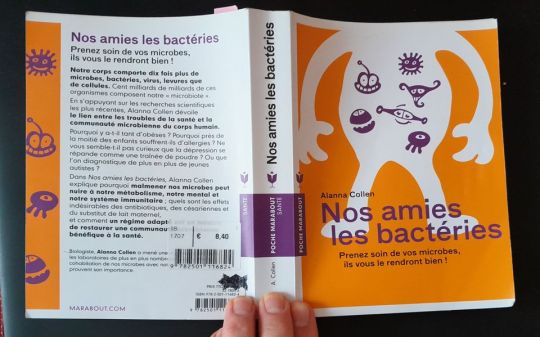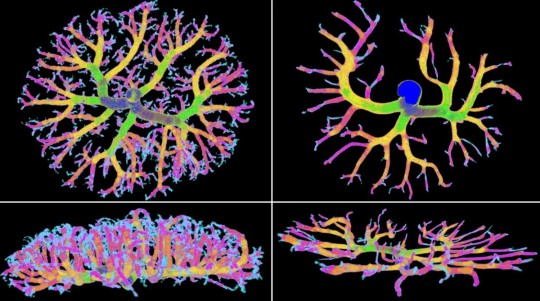#Microbiotic
Explore tagged Tumblr posts
Text

What are the Right Probiotic Foods for Your Stomach?
Probiotics, also called good bacteria, are the living microbes that help us maintain healthy bodies if consumed in the right quantities.
0 notes
Text
Podcast – Une série d'épisodes pour comprendre la fatigue chronique et les maladies modernes avec le Dr Grégoire Cozon, immunologiste
[et_pb_section fb_built=”1″ _builder_version=”4.16″ global_colors_info=”{}”][et_pb_row _builder_version=”4.27.4″ background_size=”initial” background_position=”top_left” background_repeat=”repeat” global_colors_info=”{}”][et_pb_column type=”4_4″ _builder_version=”4.16″ custom_padding=”|||” global_colors_info=”{}” custom_padding__hover=”|||”][et_pb_text _builder_version=”4.27.4″…
#Dr Grégoire Cozon#Fibromyalgie#Syndrome de fatigue chronique#podcast santé#podcast fatigue chronique#podcast immunité#maladies inflammatoires#maladie de Lyme#candidose chronique#syndrome de l’intestin irritable#alimentation anti-inflammatoire#immunologie#errance médicale#microbiote intestinal
0 notes
Text
🌿 PROBIO 3+ avec Canneberge 🌺
youtube
Protégez votre flore intestinale ET vos voies urinaires!
💪 7 souches probiotiques + fibres + antioxydants
🍒 La canneberge soutient votre système naturellement.
Digestion, confort, énergie… ressentez la différence! ✨
Un bouclier santé dans chaque capsule!
📌 À découvrir absolument!
Garantie de satisfaction. Pour plus d'informations contactez-moi par message.
#Probio#3Plus#Canneberge#SantéIntestinale#Probiotiques#BienÊtre#Microbiote#DétoxNaturelle#SantéUrinaire#Immunitaire#Vitalité#FloreIntestinale#SantéNaturelle#DigestionFacile#ImmunitéNaturelle#SantéGlobale 🍓🦠💧🌿✨#Youtube
0 notes
Text
Une nouvelle forme de vie ?
Les obélisques, des virus d’un genre nouveau Décidément, notre organisme est vraiment une terra incognita. En novembre 2024, une équipe de chercheurs américains de l’université Stanford a publié dans le magazine Cell une stupéfiante découverte : une toute nouvelle classe d’entités biologiques pullule à l’intérieur des bactéries des microbiomes humains.
0 notes
Text
Transformez votre corps avec le programme Boost
1 Mois pour Perdre du Poids et Réduire l’Inflammation Transformez votre corps avec le programme Boost, une méthode naturelle accompagnée d’un plan nutritionnel ! Pourquoi choisir le programme Boost ? 🌿 Approche 100% naturelle: Des compléments alimentaires Live Clean 🥗 Plan nutritionnel : Un programme alimentaire alcalinisant et anti-inflammatoire 💪 Résultats en 1 mois : Un corps détoxifié, un…
#alimentation anti inflammatoire#comment perdre du poids rapidement#detox#detox naturelle#ménaupose#métabolisme#microbiote#objectifs#perdre du poids#perdre du poids pendant la ménopause#perdre du poids sainement#perte de poids
1 note
·
View note
Text
TDAH à travers le prisme de l’axe intestin-cerveau (org. Isabelle Massat)
Symposium TDAH, mes petites notes comme je peux, lacunaires et sans doute avec des erreurs et approximations. Des milliers d’articles autour du microbiote! Fascinant car balbutiements de la recherche mais déjà une vision beaucoup plus holistique de la santé mentale. Il faut bien se plonger dedans, car risques d’en rester au superficiel avec petits conseils de nutrition. Les mécanismes…
0 notes
Text

Alanna Collen, Antibiotiques et Microbiote Intestinal
Rebelote pour une antibiothérapie qui déséquilibre la flore intestinale, des probiotiques qui la rééquilibrent et des fibres qui améliorent le terrain µ-biotique. Les antibiotiques peuvent sauver des vies dans les cas avancés d’infection, certes… mais… autant prendre connaissance de ce qui suit pour se mettre en chemin pour trouver d’autres solutions moins dévastatrices.
« Puisque certain antibiotiques favorisent la prolifération des C. diff [ndr – clostridium difficile], une question se pose : modifient-ils, oui ou non, la composition du microbiote ? Et pour combien de temps ? La plupart de ceux qui prennent des antibiotiques se plaignent de ballonnements et de diarrhées. Il s’agit là des effets secondaires les plus courant de ces médicaments, qui s’expliquent bien entendu par une modification du microbiote – la dysbiose. En général, tout s’arrange quelques jours après l’arrêt du traitement. Mais les microbes qui y ont survécu ? Leurs populations parviennent-elles de nouveau à un équilibre harmonieux pour notre santé ?
Une équipe de chercheurs en Suède s’est posé la question en 2007. Ils s’intéressaient en particulier au sort des bacteroides [lat.], du fait de leur rôle dans la digestion des glucides d’origine végétale et de leur considérable incidence sur le métabolisme de l’homme [...]. La moitié des participants à l’étude tous en parfaite santé ont pris pendant une semaine de la clindamycine et les autres, rien du tout. L’ingestion d’antibiotique a terriblement affecté les microbes intestinaux des volontaires, dès le début du traitement : la diversité de leurs bacteroides, notamment, s’est bien réduite. Les chercheurs ont continué à suivre l’évolution du microbiote des participents à l’étude de longs mois durant, mais même à la fin, les bacteroides du groupe sous clindamycine n’avaient toujours pas retrouvé leurs proportions d’origine. Deux ans après l’arrêt du traitement antibiotique. »
S’en suit un exposé sur la ciprofloxacine, un antibiotique à large spectre prescrit tant en cas d’infection urinaire que de sinusite qui dérègle en moins de trois jours la composition des espèces de l’intestin.
« Même l’incidence du traitement le pluscourt à faible dose se prolonge longtemps après les troubles qui l’ont justifié. Ce n’est pas forcément plus mal me direz-vous : un changement peut aussi se traduire par une amélioration. Songez toutefois à la recrudescence des maladies du XXIe siècle : le diabète de type 1 et la sclérose en plaques dès les années 1950, les allergies et l’autisme dès les années 1940. L’épidémie d’obésité a été attribuée à l’apparition des supermarchés et aux plaisirs de la consommation à outrance à laquelle ils incitent. Mais quand se sont-ils multipliés ? Dans les années 1940 et 1950. Soit à l’époque où Anne Miller a réchappé de justesse à la Grande Faucheuse. Ou encore au moment du Débarquement : c’est à partir de 1944 que l’usage des antibiotiques s’est généralisé. […]
mais pas de conclusion hâtive ! Comme tout bon scientifique s’empresserait de le rappeler : une corrélation n’implique pas forcément un rapport de cause à effet. A priori, l’introduction auprès du grand public des antibiotiques n’a pas plus de relation avec la généralisation des maladies chroniques que l’ouverture des premiers supermarchés en libre service dans les années 1940. La concomitance de deux phénomènes, si elle aiguille sur une piste, ne signifie pas qu’ils sont liés. […]
On sait depuis les années 1950 que les antibiotiques ne favorisent pas seulement le gain de poids des animaux d’élevage mais aussi des êtres humains. […] des médecins pionniers avertis de l’incidence récemment mise en évidence des antibiotiques sur le développement du bétails, en ont par exemple prescrit à des prématurés et à de jeunes enfants souffrant de malnutrition. Les résultats ont été spectaculaires : leurs patients se sont assez remplumés pour échapper à la menace de la mort. Quand on songe toutefois à la quantité d’individus aux kilos superflus de nous jours, peut-être de telles “guérisons” auraient-elles plutôt dû alerter la communauté scientifique. »
Alanna Collen décrit une études faites en 1953 sur les jeunes recrues de la marine US qui mit en évidence que les appelés qui avaient pris de la l’auréomycine avaient pris plus de poids que ceux qui avaient pris un placebo.
« Il y a de quoi s’indigner que [l’] effets [des antibiotiques], pourtant indéniable, sur les animaux et même les être humains, ait été négligé en tant que piste de recherche quand on songe aux proportions acquises par le problème de surpoids. On sait que les antibiotiques font grossir, vu qu’on s’en sert pour accélérer la croissance des animaux d’élevage et remédier aux problèems nutritionnels de ceux d’entre nous qui en ont le plus besoin. Malgré tout, on n’en a pas tenu compte dans le contexte d’un désastre sanitaire à l’échelle mondiale. »
A. Collen présente ensuite des études qui ont permis de mettre en relief certaines souches de bactéries intestinales qui favorisent ou non l’embonpoint.
« Le plus préoccupant, c’est que bien qu’un retour à la normale du microbiote suive l’arrêt du traitement, ses effets sur le métabolisme s’avèrent malgré tout durables. La pénicilline est l’antibiotique le plus communément prescrit aux enfants et, à en juger par l’exemple des souris, son ingestion trop précoce occasionne des changements IRRÉVERSIBLES du métabolisme. […]
depuis 2006, il est interdit aux éleveurs de l’Union européenne d’utiliser des antibiotiques rien que pour augmenter le poids du bétail, même s’ils servent encore à l’occasion à traiter des infections. Aux États-Unis et dans maints autres pays, on continue de gaver les animaux ‘antibiotiques pour qu’ils prennent plus de poids plus vite. »
A. Collen se demande alors dans quelle mesure nous n’ingérons pas de résidus d’antibiotiques à notre insu tant en consommant de la viande qu’en étant végétarien dont les légumes qu’ils consomment risquent fort d’être engraissés par du fumier issu d’animaux ayant reçu des antibiotiques.
Certaines personnes se retrouvent alors dans un tel déséquilibre de leur µ-biote intestinal, en grande souffrance, atteint par une prolifération du clostridium difficile contre lequel aucun antibiotique ne fonctionne, que la seule solution qu’il leur reste proposée par le système de “santé” actuel est le transplantation de selles issues d’un personne en bonne santé. Peu ragoûtant, mais des personnes en grandes souffrance, s’appuyant sur des vidéos Youtube, ont fini par passer les selles de leur conjoint au mixer pour se les injecter ensuite dans le “siphon”, vu qu’on les hôpitaux de leur État leur refusait cette thérapie de la dernière chance. Pour les adultes ce sont les fibres des légumineuses (lentilles, pois cassés, haricots...) qui servent de terrain d’accueil aux bonnes bactéries, aux probiotiques du côlon. Pour le nourrisson, ce sont les oligosaccharides issus du lait maternel.
La suite détaillée dans le livre…
Pour conclure cet exposé succinct, je ne peux que repenser au père d’un ami qui, en fin de vie, fini sa course ici-bas avec un staphylocoque doré contre lequel on ne pouvait rien. On nous parle de bactéries “résistantes” aux antibiotiques… on reste dans la logique de guerre contre le vivant et dans cette logique on préfère les bactéries “collabos”.

‣ Alanna Collen, « Nos amies les bactéries », Poche Marabout, 2015, 409 pages, p. 216-224.
#santé#antibiotiques#microbiote#intestins#bactéries#infection#érysipèle#staphylocoque#peau#dermatologie#clindamycine#alanna collen
1 note
·
View note
Text
What are the Right Probiotic Foods for Your Stomach?
Probiotics, also called good bacteria, are the living microbes that help us maintain healthy bodies if consumed in the right quantities.
0 notes
Text
Podcast → Dopage involontaire, probiotiques, mercure et solitude. La solitude n’est pas un simple coup de blues : c’est un facteur de risque aussi grave que le tabac. Elle affaiblit le système immunitaire, augmente le stress, modifie certains gènes, et touche majoritairement les 30-44 ans. On parle aussi d’un probiotique capable de neutraliser le mercure dans les poissons, et d’une étude rassurante sur les résidus de dopants dans la viande américaine. Pour voir ça rendez-vous en bio @fitnessmith, cliquez sur le lien fitnessmith.fr/news puis dans « les nouveautés » ou rendez-vous dans votre boîte mail. Voici le sujet : Au programme : • La solitude, l’épidémie silencieuse qui met votre santé en péril • Un probiotique capable de neutraliser le mercure du poisson • Et une étude sur la viande US qui rassure les sportifs #solitude #santémentale #podcastfrançais #isolementsocial #santéglobale #hormones #microbiote #probiotiques #neurosciences #bienetre #podcastdujour #santéintestinale #connexionhumaine #stress
#cortisol#dopamine#effets solitude#études solitude#gènes#Harvard solitude#hormones#immunité et isolement#Inflammation#isolement social#lien social#liens sociaux#maladies solitude#mercure poisson#methylmercure#microbiote#microbiote humain#Podcast bien-être#podcast cerveau#podcast émotion#podcast isolement#Podcast santé#podcast science#poisson grossesse#probiotiques mercure#réseaux sociaux santé#santé intestinale#santé mentale#solitude#stress
0 notes
Note
What’s another thing you want to talk about that no one has ever bothered to ask? Please enlighten us all on this topic.
There's always a pang of nervousness when GIL starts getting supertheoretical, so it's possibly understandable why no one has ever asked about vestigial organs. AKA ...
Are there any features of Gallifreyan anatomy that are redundant or dormant?
Every species has a biological junk drawer, and Gallifreyans cannot be the exception. On Earth, humans have question-mark features, such as the appendix, tailbone, wisdom teeth, ear muscles, and the nictitating membrane—structures that once served a purpose but now mostly just sit there, waiting to be inflamed.
On Gallifrey, the situation is made more complex by one fundamental fact:
🧬 Evolution Was On Hold (Sort Of)
Gallifreyans haven't evolved naturally since the Dark Times. Their development has been regulated, rerouted, and retrofitted through biodata manipulation and Loom-based engineering. Traditional Darwinian selection pressures were effectively paused the moment their society had to resort to Looms post-Curse.
However, their original biology—whether evolved or lifted wholesale from some prehistoric, likely reptilian species—still left its fingerprints. And unless something was deliberately erased, weird remnants hung around.
So, below are a few candidates for Gallifreyan anatomical redundancy. Everything here is speculative, but grounded in comparative xenobiology and the limited hard data available.
🧻 Appendix
(Appendicula Rassiloni, pending formal name)
There is reason to believe that Gallifreyans possess an appendix, or at least a small, lymphoid-adjacent structure at the junction of their upper and lower gut tract. Despite genetic engineering, this structure appears to persist.
On Earth, the appendix is theorised to serve an immune or microbiotic support role. Since both species appear to retain this organ:
It may play a similar immunological buffering role in Gallifreyans
Or it's a pure evolutionary artefact—possibly linked to ancestral high-cellulose or herbivorous diets
Surgical removal seems to have occurred and appears to be safe.
🧬 Reproductive Organs
Gallifreyans did not reproduce biologically for millennia. During the Curse of the Pythia era, the species lost all fertility, leading to the rise of Looms. For thousands of years, reproductive organs were present but not able to do what they were designed for.
What's interesting is that these systems were never removed from the genetic template. They were retained—like a shrine to something no longer believed in.
These organs were vestigial for a very long time
With the lifting of the curse, biological reproduction resumed (take it up with Professor Davies)
Modern Gallifreyans are fully fertile, and those organs are now functional again
This may be the only known example in xenobiology of a vestigial system reactivating across a species.
🧠 The Third Brain Stem
Gallifreyans have three brain stems (or two, or one, but the highest claimed is three). In human neuroanatomy, the brain stem regulates autonomic functions—breathing, heart rate, etc.—but in Gallifreyans, most of that is managed by the autonomic brain, a specialised structure near the cerebellum. This begs the question—why an utter overkill of three brain stems?
The three brain stems appear to serve primarily as high-speed neural relays:
93 pairs of nerves (as opposed to Earth's 12) branch from the brain stems into the spinal column
This enhances bodily coordination, reflex speed, and neural multitasking
But it's not entirely clear why they need three
Speculation: the third stem may once have supported intensive psionic integration or higher-dimensional sensory routing, both of which have atrophied in modern Gallifreyans. If so, it may now operate as redundancy—no longer essential, but still maintained.
👁️ Superior Epiphysis Cerebri
This is a structure we know about: a gland located just above the regular epiphysis cerebri (pineal gland). It appears to allow Gallifreyans to perceive higher dimensions—but only when consciously activated and trained. Most Gallifreyans go their entire lives without ever doing this.
Likely used more frequently in ancient times when psionic activity was stronger
Technically functional, but unused in the vast majority of citizens
So not vestigial, but dormant, unless awakened.
📉 Psionic Atrophy
It's worth noting that the ancestral Gallifreyans—the Shobogans—were far more psychically potent than the average modern Gallifreyan.
Today, despite all their biotech enhancements, many Time Lords rely on trained psionic ability rather than raw talent. This reflects a decline in natural telepathy.
So while the psychic system isn't vestigial, much of its organic infrastructure may be. The unused 'old wiring' may still be embedded in the brain, waiting to be rerouted or accidentally activated.
🏫 So...
Some organs are sleeping. Some have been reactivated. Some may be the last echoes of a people who once danced naked around cauldrons and ate raw Sealak. GIL continues to investigate.
Related:
💬|🧬🐒What does the evolution lineage of Gallifreyans look like?: Highly theoretical look at how Gallifreyans evolved.
💬|🏺🧙What do Shobogans look like, and how are they different from modern Gallifreyans?: Various biological difference between Gallifreyans and their ancestors.
📺|🧶👶What is looming and how does it exist alongside natural reproduction?: Overview of looming and its place alongside natural reproduction in Gallifreyan society.
Hope that helped! 😃
Any orange text is educated guesswork or theoretical. More content ... →📫Got a question? | 📚Complete list of Q+A and factoids →📢Announcements |🩻Biology |🗨️Language |🕰️Throwbacks |🤓Facts → Features: ⭐Guest Posts | 🍜Chomp Chomp with Myishu →🫀Gallifreyan Anatomy and Physiology Guide (pending) →⚕️Gallifreyan Emergency Medicine Guides →📝Source list (WIP) →📜Masterpost If you're finding your happy place in this part of the internet, feel free to buy a coffee to help keep our exhausted human conscious. She works full-time in medicine and is so very tired 😴
#gallifrey institute for learning#dr who#dw eu#ask answered#whoniverse#doctor who#time lord biology#GIL: Asks#gallifreyan biology#GIL: Biology#GIL: Biology/Foundations#GIL: Species/Gallifreyans#GIL: Gallifrey/History#GIL: Gallifrey/Technology#GIL#GIL: Biology/Nervous#GIL: Biology/Psionic
18 notes
·
View notes
Text
i know that robopearl is probably just pearl talking through a drone, but i will accept this which is most likely a mistranslation. pearl is so small she can comfortably crawl up in there and pilot it like a microbiotic eva

236 notes
·
View notes
Text
Getting tired very easily of the stupidest trends of self hate showing up on my insta feed. For every thick haired girl that talks about whatever stuff hair related there's three or four accounts appearing on my feed ran by influencers hating their thin hair like "oooh as a thin hair girlie I could never!!" "Trying to do the reverse ponytail whatnot but realising I'm not a thick hair girlie"
Everything is appealing to self hate EVERYTHING. Everyday there's something NEW that is WRONG with me : thin hair, eye colour?? Moon face, weak nails, gut microbiote, the I way I've been eating broccoli IT'S EXHAUSTING MY GIRLIES IN CHRIST
Influencers run out of shit to say and the first thing they do is to draw upon self hate discourses CAMOUFLAGED AS SELF IMPROVEMENT TIPS. The lexicon they use is disturbing and very close to doublespeak like "It's not wrong to have a roman nose but here are some tips to style your bangs so you can look like that actress from New Girl" Social media became UNBEARABLE, I'm being constantly bombarded with Cosmopolitan and Vogue editorials about how wrong I'm being a human being! I'm not even interested in being a woman, wtf???!!! I THOUGHT WE WERE PAST THAT
No darling there's nothing wrong nor right having a certain form of eyelids or lips bodies are bodies and that's just it there's nothing inherently WRONG OR RIGHT about them just stupid ideas about what's trendier
51 notes
·
View notes
Text
Le placenta se forme avec l'aide du microbiome de la mère
https://www.nature.com/articles/d41586-023-03105-3

View On WordPress
0 notes
Note
How's your immune system? Gamer hair is grossssss. You'll give yourself incel cooties. 🏁
Immune system functioning adequately. Hair sufficiently washed and cared for. Microbiotic landscape no more putrid than the average human, less so even.
5 notes
·
View notes
Text
Renforcer son système immunitaire cet hiver grâce aux remèdes naturels

Plantes, alimentation et habitudes de vie pour soutenir vos défenses naturelles
L’hiver met à rude épreuve notre système immunitaire avec les températures glaciales, la circulation des virus et la réduction de la lumière naturelle. Pour fortifier nos défenses, les plantes et huiles essentielles représentent des alliées de choix. L’échinacée, en stimulant la production de globules blancs, aide à prévenir les infections. Le ginseng, quant à lui, soutient l’organisme face au stress et à la fatigue. Le thym, aux vertus antiseptiques et le curcuma, puissant anti-inflammatoire, renforcent également l’immunité. De plus, les huiles essentielles de ravintsara et d’eucalyptus radié sont particulièrement efficaces pour désencombrer les voies respiratoires et protéger l’organisme des infections hivernales.
Une alimentation équilibrée est pareillement cruciale pour maintenir un système immunitaire fort. Les légumes de saison, tels que les courges, choux et brocolis, sont riches en vitamines et antioxydants, tandis que les fruits comme les kiwis et les oranges stimulent la production de globules blancs. Les poissons gras et les produits de la ruche, comme le miel et la propolis, apportent des nutriments essentiels pour renforcer les défenses. Les probiotiques et prébiotiques, eux, favorisent un microbiote intestinal sain, clé d’une bonne immunité.
En plus d’une alimentation et de remèdes naturels adaptés, certaines habitudes de vie jouent un rôle fondamental pour préserver la santé durant l’hiver. Avoir une exposition régulière à la lumière naturelle, pratiquer une activité physique modérée, avoir un sommeil réparateur, maintenir une bonne hydratation et gérer le stress par des techniques de relaxation comme la méditation sont autant de pratiques qui renforcent le système immunitaire et permettent de mieux résister aux agressions extérieures. Ces habitudes naturelles sont essentielles pour traverser l’hiver en pleine forme.
Le produit Feuilles entières pour décoction de Herbal D-Tox est un excellent complément pour soutenir l’immunité en hiver. Ce mélange de plantes, conçu pour être infusé en décoction, aide à renforcer les défenses naturelles et à purifier l’organisme en éliminant les toxines. Facile à intégrer dans votre routine quotidienne, il offre des bienfaits revitalisants, parfaits pour combattre la fatigue et le stress hivernaux, tout en procurant une sensation de bien-être durable.
Sources :
#ImmunitéHivernale#RemèdesNaturels#PlantesPourSanté#HuilesEssentielles#AlimentationSaine#DéfensesImmunitaires#SystèmeImmunitaire#BienÊtreNaturel#SantéHivernale#PréventionSanté#HerbalDetox#MédecineDouce#Gemmothérapie#RéflexeNaturel#PlantesAdaptogènes#HiverEnForme#VitalitéHivernale#ProtégerSonImmunité
1 note
·
View note
Text
youtube

“the only hope was for them to become small enough to go into one of his mitochondria.”
👇Read A Wind in the Door by Madeleine L’ Engle
https://www.readanybook.com/online/601304




I’ve always thought this was the coolest shit GL ever came up with!!!





NGL, I would love love love to see GL’s ideas used in Rey’s movie! To see Ben returned to her at the end of it would be a dream come true!! The microbiotic world of Star Wars(midi-chlorians and the Whills), the Dyad reunited…I need LF to be brave!!!
Read my own Episode X! It’s got midi-chlorians, Rey and Ben, and lots of other cool stuff too!! Enjoy while we wait for the next Star War!!!
#star wars#midi-chlorians#the whills#reylo#rey#ben solo#dyad#sharmeen obaid-chinoy#a wind in the door#madeleine l'engle#a wrinkle in time
4 notes
·
View notes